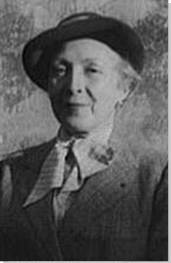Summary of Marie Laurencin
Marie Laurencin played a significant role in negotiating female and lesbian identity in early-20th century modern art movements dominated by men. From early in life, Laurencin was predominantly interested in worlds in which women moved independently and peacefully, creating self-portraits and scenes featuring animals and women which were striking in their thematic consistency. Laurencin's name was made through her association with Cubism, exhibiting with the Section d'Or and in the Armory Show, but as a mature artist resisted dominant artistic movements. Laurencin developed her own aesthetic, favouring escapist imagery in pastel hues, that was at once decorative and radical in its embrace of feminine tropes. The artist, throughout her life, embraced the ambiguous and the ephemeral, creating a body of work that offers a confident and self-sufficient vision of female affection and creativity.
Accomplishments
- Laurencin's images of female identity, often alluding to her own position as an artist or to spontaneous creative rituals such as dance or dress, created links between lesbian identity and creative fertility. Laurencin's paintings, drawings and prints consistently presented the possibility of escape into a world without men, constructed through visual tropes - such as pastel colors, scarves and animals - associated with the feminine.
- Marie Laurencin created a style distinctively her own whilst expanding upon earlier periods and movements in both art and literature. She borrowed symbolic imagery, such as fans and deer, from Rococo painting, experimented with unusual color schemes as did the Impressionists and drew upon modern ideas of abstraction in stripping her images of extraneous detail. Her dreamlike sensibility, meanwhile, borrowed from Symbolist poetry.
- Laurencin's paintings were unashamedly pleasurable, celebrating art as something that could serve a decorative purpose. She frequently collaborated on sets and costumes for ballet, along with interiors, and created images that prioritised the instinctive over the intellectual, serving as arguments for the value of beauty as the art world moved toward theory-dominated practice.
The Life of Marie Laurencin
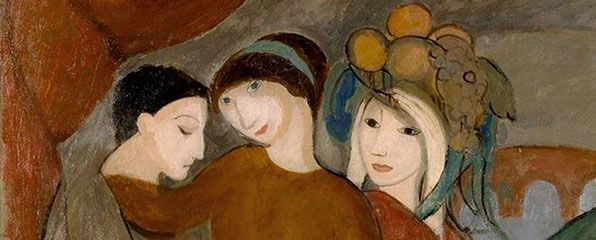
In post-war Paris, Marie Laurencin proved herself as both an eccentric artist and businesswoman. She charged higher prices for work which she found dull than for that which she enjoyed; she charged men double what she asked of women and charged brunettes more than blondes. But it did her legacy no harm and in 1983 the Musée Marie Laurencin opened in Japan - it was the first museum in the world devoted to a single female painter.
Important Art by Marie Laurencin
Self-Portrait
This self-portrait dates from Marie Laurencin's time at the Académie Humbert and illustrates both her growing understanding of nineteenth-century academic painting along with her intuitive use of color. Laurencin depicts herself in a white smock, looking directly at the viewer with a neutral expression, her hair tucked behind her face. The palette is dominated by browns, whites and pinks and Laurencin uses color to model her face, with pinks shaping the sides of the nose and the eyelids and browns and greys indicating shadows around her cheeks, which have an unnatural whiteness that hints at her future use of the color. Her lips, at the center of the canvas, are red and full.
Laurencin painted self-portraits throughout her career and her interest in using and returning to herself as a subject ties closely to her interest in female independence and self-fashioning. Laurencin presents herself as an independent artist and as a modern woman; she wears the smock of a painter and adopts a serious expression and confident pose, meeting the gaze of the viewer.
This self-portrait, like those Laurencin completed both previously and later in her career, can be viewed as contributions to a tradition of female portraiture that extended back to the eighteenth century, drawing from painters such as Elizabeth Vigée-Lebrun and patrons such as Madame de Pompadour who controlled their own representation as a means of grasping independence and agency within masculine artistic circles.
Oil on canvas - Musée Marie Laurencin, Nagano, Japan
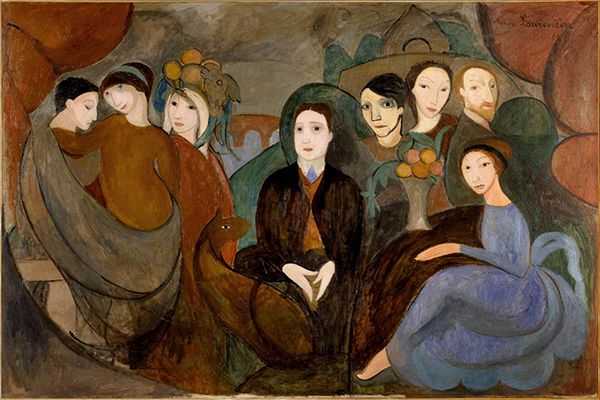
Apollinaire and his Friends
This painting shows Guillaume Apollinaire surrounded by a group of friends, including Laurencin herself. Apollinaire sits at the centre of the painting, gazing forward, his hands folded on his knee, with a dog beneath him that turns its head back toward the poet. Gertrude Stein, Fernande Olivier and an unknown woman with a lavish headdress appear to the left of Apollinaire while Pablo Picasso, Marguerite Gillot and Maurice Cremnitz are grouped to the right, behind a vase of flowers. Laurencin appears seated on the ground in a pale blue dress, her body and leg turned toward Apollinaire while her head turns toward the viewer. Apollinaire and His Friends is predominantly painted with earthy, subdued browns and greys, with Laurencin's blue dress and Apollinaire's blue tie serving both to connect the pair within the image and draw attention to their figures.
Laurencin painted this group portrait as a gift and homage to Apollinaire, following Gertrude Stein's purchase of a smaller canvas with the same title, and it serves as a showcase of the couple's position within Parisian avant-garde circles and of the ways in which this group mythologized themselves. While the color scheme is suggestive of Picasso and Braque's influence, Laurencin's interest in softer shapes and classicism is evident; the faces of the figures are stylized, flat and rounded, without extensive modelling, while the arrangement of the group at the left follows that of the Three Graces, a popular theme in antiquity. Apollinaire installed this painting above his bed in his apartment on the Boulevard Saint-Germain, where it remained throughout his life and after his death was preserved by his family.
Oil on canvas - Musée Picasso, Paris
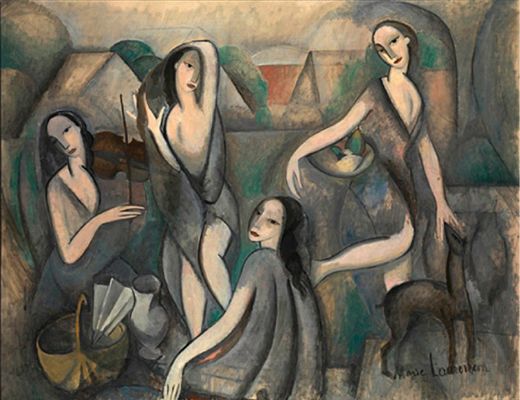
The Young Girls
The Young Girls shows four women, independent but overlapping, all with pale skin, dark eyes and dark hair, robed in grey and posing against an abstracted pastoral backdrop. On the left is a violinist, playing music for the figure beside her, who dances. At the centre, a seated woman, facing the dancer, turns to look back over her shoulder toward the viewer. On the right, another woman appears in motion, carrying a bowl of fruit under her right arm and reaching down with her left to stroke the nose of a doe. The limbs of the women are fluid, following the drape of their dresses, and their bodies are outlined with heavy black lines.
The Young Girls is illustrative of Laurencin's skill in experimenting with different artistic styles whilst developing her own interests and visual language. The posing of the four women and their flat, mask-like faces are strongly suggestive of Picasso's Les Demoiselles d'Avignon (1907), while the flat planes of the village behind call to mind Braque's Houses at L'Estaque (1908). This painting, however, differentiates itself from these influences through the use of the four women to suggest a fertile sphere of feminine creativity, suggested both through the circle created by the figures' positioning and through the presence of the doe, a symbol of femininity and naturalness that Laurencin frequently employed. The performance, in which the women are both participants and observers, is reminiscent of those Laurencin regularly attended at the home of Natalie Barney and The Young Girls can be read as a contribution to this tradition of lesbian self-fashioning and as a celebration of an independent female realm.
Oil on canvas - Moderna Museet, Stockholm, Sweden
Marie Laurencin and Cecilia de Madrazo
This portrait shows Maire Laurencin and Cecilia de Madrazo, a collector and friend of the artist, with the head of a dog poking up between the pair. Marie Laurencin, on the left, is shown wearing a pink dress with short hair that conceals her ears and forehead; her cheeks and lips are pink, while her skin is grey, and her black eyes look down and out of the painting. On the right, Cecilia plays with the dog, looking down toward it and reaching a finger towards its extended snout. Her skin is almost white, with pink lips and cheeks, and she wears a grey dress and has a white hat, with large blue bow, atop her dark hair. The backdrop, rendered with little detail, is grey and there is a pink curtain at the right edge of the painting; the color scheme is very limited, with Laurencin utilising only grey, pink, blue and very small amounts of beige.
This painting is emblematic of Laurencin's work, which has been both appreciated and criticised for its deliberately feminine aesthetic, with the painter prioritising pastel colors and soft edges. The figures appear peaceful and charming, in possession of conventional female virtues including beauty, taste and docility. Laurencin embraced the idea that women and her paintings could be decorative, but critical dismissal of 'decorative' and anti-intellectual art meant that male artists saw her work as embodying feminine weakness and early feminist critics felt her representation of womanhood played into such arguments. Laurencin's unashamed embrace of visual pleasure, however, and the development of an aesthetic that celebrated female softness, elegance and sweetness is itself a radical position. This painting, moreover, presents these qualities as part of a creative process in which the masculine is utterly unnecessary, with women presented as both artist and subject; Laurencin's focused downward glance, as if at a canvas, reminds the viewer of her profession.
Oil on canvas - Collection of the Tate, United Kingdom
The Fan
The Fan features a pink shelf that holds two images of women, one in a rectangular frame and the other in a round frame, against a pink and grey background. The portrait to the left, in the larger, rectangular frame, shows a woman and a dog in greyscale accented by a pale blue ribbon, hat and curtains, while the round frame at the centre of the painting shows a woman presumed to be Marie Laurencin herself, though it is unclear if this is a portrait or a mirror. The lower right corner of the image is dominated by the folds of a fan, rendered in grey and white, that is cut off at the canvas's edge. The pastel hues and soft, apparently boneless figures are recognisably of Laurencin's mature style.
The positioning of the fan in this image, as if held by a figure gazing at the frames on the shelf, implicates the viewer in a narrative that remains vague. The portraits on the shelf are arranged such that the figures within the frames appear to meet the viewer's gaze; the arrangement and display of such portraits suggests an intimacy between their subjects and the unseen figure holding the fan, in whose place the viewer is positioned. The Fan derives its emotional pull through this intrigue and ambiguity, raising questions as to the identity of both the subjects and owner of these portraits and their relationships. It has been suggested that the woman in the rectangular frame is Nicole Groult, a dressmaker with whom Laurencin likely had a romantic relationship. The display of portraits provokes - through the representation of figures presumed to be elsewhere - a sense of longing that can, given the context of exile in which it was created, read as a commentary on absence and longing.
Oil on Canvas - Collection of the Tate, United Kingdom
Spanish Dancers
Spanish Dancers shows three women, in blue, pink and white, dancing with a horse and dog against a grey and black backdrop with subdued hints of green. On the left, the woman in blue extends her leg and points her toe, her body extending the height of the canvas, with one hand holding the edge of her grey hat while the other reaches back toward the horse that is partially obscured by her body. The dancer on the right side of the canvas, in white, also strokes the horse's mane, while the dog at the centre of the image leaps up toward her hand. In the foreground, a woman in a pink, tutu-like dress with bent legs, who has been described as Laurencin herself, extends her hand toward the dancer in white and leans back, turning her face toward the viewer and directing her gaze toward the base of the canvas. The eyes of all three women are rendered simply, as thick black lines with dots at the centre, and there is little modelling or use of line to indicate the edges of faces, hair or fabrics, creating connection between the women and animals whilst contributing to the sense of fluid motion within the dance.
Spanish Dancers sees Laurencin combining her signature color scheme with a more ambitious composition, likely influenced by her time in Spain, where she completed a number of sketches and smaller paintings on the same theme. Laurencin's style in this painting imbues the dance with particular characteristics. The softness of the figures and the limited color palette creates a sense of harmony, reinforced by the overlapping of the animals and women within the composition; the horse's large eye, close to that of the woman in blue, suggests gentleness and trust. Laurencin, as is typical across her oeuvre, does not develop the painting's setting, the shadowed backdrop contributing to the construction of a closed world in which dancers and animals are allied, content and self-sufficient. Spanish Dancers celebrates the ephemeral, with the soft edges of the figures and the undulating lines of limbs and fabrics suggestive of dance's fleeting nature, echoing and alluding to the impermanence of sensual pleasures.
Oil on canvas - Musée de l'Orangerie, Paris
Portrait of Mademoiselle Chanel
This portrait of Coco Chanel is typical of Marie Laurencin's commissions, in which she often paired women with animals and dressed her sitters in colored scarves. Chanel is shown seated, her head slightly tilted and propped on her hand, with a pale poodle on her lap. It is unclear where Chanel's flesh ends and her dress begins; her pale outfit is accented with dark black and blue scarves, while the seat behind her is a textured pink and blue. She appears relaxed and her eyes and mouth, neutral and expressionless, suggest that she is daydreaming or preoccupied by her thoughts; the poodle's expression is similarly calm. On the right, in the background, is a dove descending toward Chanel and another dog, in the shadows, leaping toward it.
Chanel commissioned this portrait in 1923, having become acquainted with Laurencin when both were designing costumes for Sergei Diaghilev. The painting, upon completion, was rejected by Chanel, who felt that Laurencin's woman did not bear enough of a likeness to her. This observation can be made of many of Laurencin's portraits; she did not deny it, but claimed that physical likeness was unimportant. Laurencin's portraits became simpler as she matured, with women stripped down to dreamlike figures that suggested a way of seeing the world in which emotion, rather than verifiable fact, was primary. Laurencin's statements, often flippant and sometimes contradictory, provided playful explanations for her distinctive style; once, she claimed to base all women's faces on the face of her cat, while at other points she argued that she simply painted what she, extremely short-sighted and without glasses, saw. Despite Chanel's rejection of the painting, the success of Laurencin's approach was such that she continued to receive and execute portrait commissions in this style until World War II.
Oil on canvas - Musée de l'Orangerie, Paris
Biography of Marie Laurencin
Childhood
Marie Laurencin was born in Paris on October 31, 1883, and grew up in an apartment with her mother, Pauline Laurencin. Laurencin was an illegitimate child and did not dare to ask her mother about her father, the politician Alfred Toulet, learning his identity only at the age of 21, though he visited the pair occasionally. Laurencin's ongoing celebration of women and femininity can be traced to her childhood years, in which her father's appearances were an unwelcome interruption. As a child, Laurencin collected portraits of European queens and delighted in visiting a convent. She read widely and enjoyed drawing, but came last in all her classes at school, which meant she could not become a teacher, as her mother had hoped.
Early Training and Work
Laurencin, who described her late teenage years as "sad, ugly and devoid of hope," responded to her academic failure by beginning to draw self-portraits, which she would continue throughout her life, and studying porcelain painting at the École de Sèvres. In 1903, she moved to the Académie Humbert, where she worked on drawing, painting and printmaking. Here, Laurencin met other artists who would become central to the avant-garde, with classmates including Georges Braque and Francis Picabia.
At the same time, Laurencin began to attend Natalie Barney's famous neo-Sapphic gatherings, at which a crowd predominantly comprised of lesbian and bisexual women socialised and discussed links between female desire and creative production. Barney envisaged her gatherings as escapes into a realm inspired by the archaic Greek poet Sappho's group on the island of Lesbos, creating a space in which societal convention could be left in favour of a realm of creativity centred upon female connection and inspiration. The influence of Barney's utopia on Laurencin's creative production can be seen throughout her oeuvre. Laurencin's first print-making efforts, in 1904, were illustrations of Pierre Louÿs's The Songs of Bilitis, a text celebrating erotic love between women. Laurencin referred to her own "preference for women" during this period, though details of her love affairs prior to 1907 are scant.
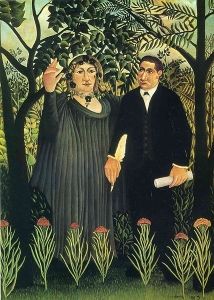
In 1907, aged 24, Laurencin had her exhibition debut at the Salon des Indépendants, held at the Gallery Clovis Sagot in Montmartre. The Cubists, with whom this exhibition is often linked, were eager to claim Laurencin as one of their own, despite her repeated resistance to such characterization of her work. At the exhibition's opening, Pablo Picasso introduced Laurencin to Guillaume Apollinaire, introducing her as Apollinaire's future "fiancée." The pair had a relationship that lasted for six years, during which Apollinaire wrote frequently about Laurencin, referring to her as "Our Lady of Cubism" and further cementing her association with the movement. Laurencin herself, during their relationship and afterwards, resisted the likening of her work to Cubism. Instead, she drew from the dreamlike imagery of modern poets, including Apollinaire, and the soft colors of Impressionists such as Auguste Renoir.
Laurencin and Apollinaire lived apart throughout their relationship; each was the illegitimate child of a single mother, with whom they continued to live. The pair never married, likely due both to the disapproval of their mothers and to their shared interest in modern life and in rejecting bourgeois convention. Their symbiosis can, instead, be seen in Henri Rousseau's 1909 portrait of Laurencin and Apollinaire, in 1909, entitled The Muse Inspires the Poet.
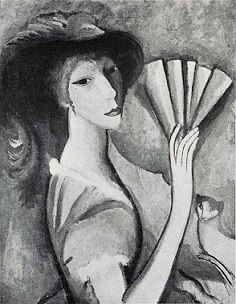
Laurencin, in this period, was a regular at Picasso's open studio at 13 Rue Ravignan in Montmartre and socialized and exhibited regularly with the group who came to be known as the Bateau-Lavoir, after the building's nickname. She met, here, Max Jacob, André Salmon and André Derain, along with Gertrude Stein, to whom she made her first sale in 1908. In 1911, Laurencin was the only woman to have work included in the Maison Cubiste, alongside others including Fernand Léger and Marcel Duchamp. When this exhibit was attacked by members of the public, Laurencin and Charlotte Mare kept guard, armed with umbrellas. In 1912, she participated in the Section d'Or exhibition at Paris's Galerie Boëtie, while in 1913 her work was included at the landmark Armory Show in New York, introducing European modernism to North American audiences.
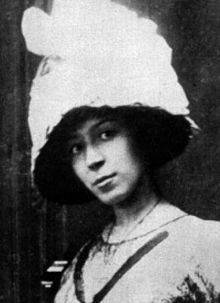
In 1913, Laurencin's mother died and she broke up with Apollinaire, who had acquired a reputation for philandering. Apollinaire only accepted that the relationship was over in 1914, when Laurencin married Otto van Waëtjen, a German painter who had been among her classmates at the Académie Humbert. This effectively ended Laurencin's relationship with Cubism, though she would remain close to Apollinaire until his death, aged 38, in 1918. Laurencin felt depressed and unstable during these years, telling friends that she had married van Waëtjen as he reminded her of her mother.
When war broke out in Europe, Laurencin and her German husband went to Spain in order to avoid France's anti-German sentiment. Here, Laurencin became involved with the Dada movement , editing 391 alongside Francis Picabia, and spent time looking closely at the work of Francisco Goya, whose dignified, dark-eyed women captivated her. In this time, too, Laurencin became close with Sonia Delaunay and Robert Delaunay, who had similarly left France to avoid the War. In 1919, Laurencin and van Waëtjen moved to Dusseldorf, where Laurencin filed for a divorce from her husband. Laurencin was asked if she had left van Waëtjen because he was German; she responded that it was, in fact, rather that he had become an alcoholic. They remained on good terms, keeping in touch until von Waëtjen's death in 1942.
Marie Laurencin returned to Paris in 1920 and produced much of the work for which she is known during the interwar period, having refined the style, subject matter and color palette for which she would be remembered. Paul Rosenberg began to act as Laurencin's dealer, giving her greater financial security, though she often disobeyed his business advice, giving her work as a gift to those she liked. Laurencin set higher prices for work which she found dull than for that which she enjoyed; she charged men double what she asked of women, charged brunettes more than blondes and had a reputation for painting only children whom she liked.
Mature Period
Laurencin's world became, after the war, far more closed. She appears to have protected her privacy more intensely than in earlier years and her experimentation with prevailing artistic trends was dropped in favor of her personal vision, creating the pastel portraits of women and dogs for which she is now known. Laurencin had a reputation, in this period, of moving from lover to lover, though the specifics of these affairs are largely unknown. It is likely she slept with some of the women she painted, including Nicole Groult, a dress designer, and was romantically involved with Armand Lowengard, a scout for the most famous art dealer of the day, Joseph Duveen, whose marriage proposals she repeatedly refused.
Laurencin's artistic media ranged widely during the interwar years. She designed wallpaper and textiles for André Groult, illustrated editions of Lewis Carroll's Alice in Wonderland and Katherine Mansfield's The Garden Party, and contributed to the French Embassy Pavilion at the Exposition Internationale des Arts Décoratifs et Industriels Modernes in 1925. She taught, informally, at Amédée Ozenfant's open studio, alongside Fernand Léger and Alexandra Exter. Laurencin's work reached a wide audience when she designed the set and costumes for Sergei Diaghilev's Les Biches, which was performed in Paris, Monte Carlo, Berlin and London in 1924. The ballet, exploring sexual fluidity in Parisian society, was a fitting choice for Laurencin and her work was well-received, though some criticised the themes of the performance. She continued to design for the theatre throughout the 1920s, creating a three-dimensional version of the world that existed within her paintings. She had, however, despite the success of her costumes, little time for fashion, often offending her sitters by covering their couture dresses with the plain scarves she kept in her studio.
By the end of the decade, Laurencin was a successful artist and sought-after portrait painter. In 1931, she was among the founding member of La Société des femmes artistes modernes, participating in their annual exhibition until the outbreak of World War II. From 1932 to 1935, she taught at the Villa Malakoff, developing teaching methods that she had explored at the Atelier Ozenfant during the 1920s. In 1937, seen as the height of her career, a retrospective of Laurencin's work was held in conjunction with the Great Exhibition of Independent Art Masters at the Petit Palais. In this same year, Laurencin acquired glasses, which changed her life considerably; she had been extremely short-sighted since childhood and had had difficulty negotiating staircases since the 1920s. Laurencin remained in Paris during World War II, painting and working on designs for the ballet, and in 1942 she published Le Carnet des Nuits - a collection of poetry with short memoir pieces in prose.
Late Period
In later years, Laurencin became increasingly isolated, suffering from bouts of depression and other health complaints, though she continued to paint throughout. Her primary companion was her maid, Suzanne Moreau, who had lived with her since 1925. It is unclear if Laurencin and Moreau were romantically linked, but this seems likely; they were certainly close and Laurencin legally adopted Moreau, then aged 49, in 1954, making Moreau the beneficiary of Laurencin's estate. This decision was perhaps prompted by Laurencin's legal struggle, resolved the following year, with tenants living in the apartment that she owned. Laurencin died of a heart attack in 1956 and was buried in Père-Lachaise, as per her wishes, with Apollinaire's love letters and a rose in her hand, wearing a white dress.
The Legacy of Marie Laurencin
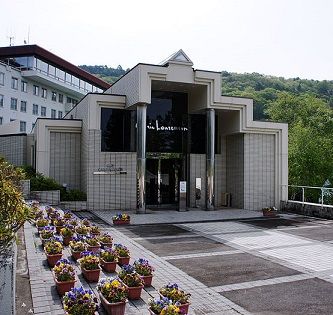
After her death, Marie Laurencin's work was largely forgotten until the 1970s, when there was a resurgence of interest spurred by Feminist and Queer Art historians. There were a number of books published, including catalogues raisonnés of both her engravings and her paintings, during the 1980s, and prominent exhibitions in France and the United States brought Laurencin's work to the attention of a new generation. In 1983, the Musée Marie Laurencin opened in Nagano, Japan, on the initiative of collector Masahiro Takano, an executive at Hitachi Systems, who began to collect Laurencin's works in the 1970s; it was, at this point, the only museum in the world specialized to focus on a female painter. Her reputation has since continued to grow.
Laurencin's influence can be seen across the work of a number of artists who have employed visual languages of femininity in order to explore the place of women and gender expectations in modern life. Louise Bourgeois, Laurencin's most celebrated student, similarly used clothing and other symbols of womanhood in order to explore female relationships, using psychoanalytic ideas to consider familial relationships, the human body and emotional states. Hannah Wilke and Harmony Hammond deployed imagery associated with womanhood in order to explore lesbian identity in the wake of the civil rights movement. More recently, Karla Black's use of pastel cosmetics has expanded Laurencin's distinctive color scheme into three-dimensions and continued her project of visual pleasure as a form of female advocacy.
Influences and Connections

-
![Guillaume Apollinaire]() Guillaume Apollinaire
Guillaume Apollinaire -
![Francis Picabia]() Francis Picabia
Francis Picabia -
![Sonia Delaunay]() Sonia Delaunay
Sonia Delaunay -
![Pablo Picasso]() Pablo Picasso
Pablo Picasso - Natalie Barney
-
![Louise Bourgeois]() Louise Bourgeois
Louise Bourgeois -
![Hannah Wilke]() Hannah Wilke
Hannah Wilke -
![Grace Hartigan]() Grace Hartigan
Grace Hartigan -
![Judy Chicago]() Judy Chicago
Judy Chicago - Harmony Hammond
Useful Resources on Marie Laurencin
- Marie Laurencin, artist and museOur PickBy Douglas Hyland
- Marie Laurencin: Une femme inadaptée in Feminist Histories of ArtBy Elizabeth Louise Kahn
- Marie Laurencin (French)By Bertrand Meyer-Stabley
 Ask The Art Story AI
Ask The Art Story AI